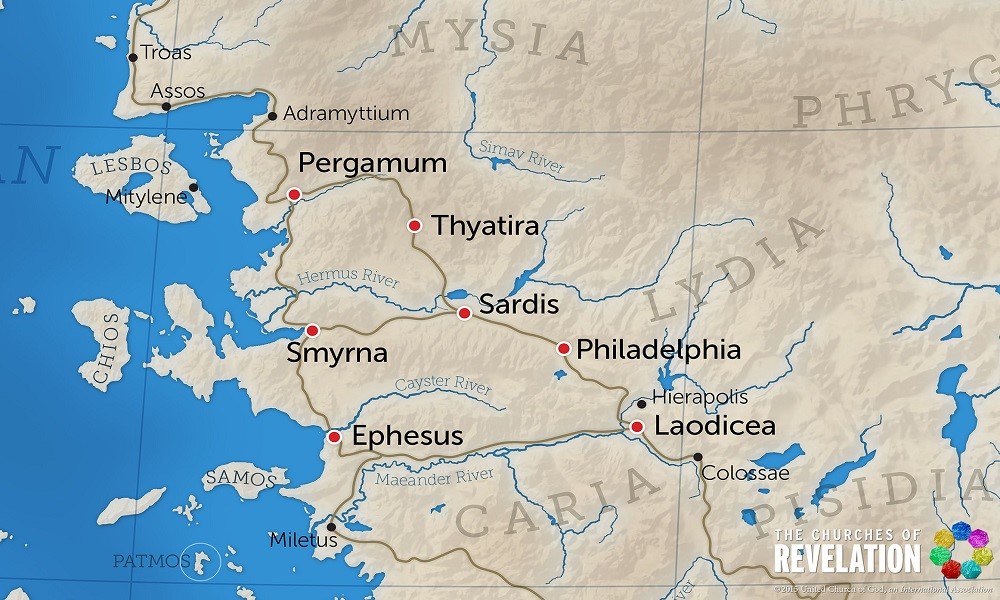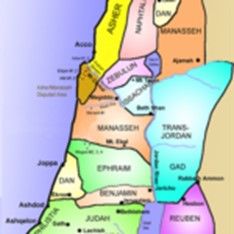Introduction of the Seven Churches of Revelation

The Revelation, [which is a disclosure of truth, instruction concerning things before unknown or a manifestation or appearance (Strong. 2001. #602)] of Jesus Christ, which the LORD God gave unto to show [that is to give evidence or proof of a thing to show by words or teach (Strong. 2001. #1166)] unto his servants [metaph., one who gives himself up to another’s will, those whose service is used by Christ in extending and advancing his cause among men (Strong. 2001. #1401)] things which must shortly come to pass; and he sent and signified [that is to make known (Strong. 2001. #4591) it by his angel [there are angels who are over churches (Strong. 2001. #32)] unto his servant John. (Revelation 1: 1).
John was the apostle, the writer of the Fourth Gospel, son of Zebedee and Salome, brother of James the elder. He is that disciple who (without mention by name) is spoken of in the Fourth Gospel as especially dear to Jesus and according to the traditional opinion is the author of the book of Revelation. (Strong. 2001. #2491). John bared witness or record to affirm that he had seen and heard by divine revelation or inspiration. (Strong. 2001. #3140) of the Word of God, and of the testimony of Jesus Christ, and of all things that he saw. (Revelation 1: 2).
Blessed is he that reads, and they that hear the words of this prophecy [which is the predictions of the works of which, set apart to teach the gospel, will accomplish for the kingdom of Christ (Strong. 2001. #4394)], and keep those things which are written therein: for the time is at hand. (Revelation 1: 3).
John was to speak to the seven churches which are identifies as a company of Christians, or of those who, hoping for eternal salvation through Jesus Christ, observe their own religious rites, hold their own religious meetings, and manage their own affairs, according to regulations prescribed for the body for order’s sake (Strong. 2001. #1577). The seven churches were identifies as being in Asia (Strong. 2001. #773). Asia proper or proconsular Asia embracing Mysia, Lydia, Phrygia, and Caria, corresponding closely to Turkey today (Easton. 1897). John was to tell the seven churches which are in Asia: Grace be unto you, and peace, from him which is, and which was, and which is to come; and from the seven Spirits which are before his throne. (Revelation 1: 4).
Jesus revealed himself to John and then instructed him to write to the seven churches. Jesus Christ, who is the faithful witness, and the first begotten of the dead, and the prince of the kings of the earth. Unto him that loved us, and washed us from our sins in his own blood, and has made us kings and priests unto God and his Father; to him be glory and dominion for ever and ever. Amen. (Revelation 1: 5-6).
Behold, he comes with clouds; and every eye shall see him, and they also which pierced him: and all kindreds which is identifies as a tribe
1a) in the New Testament all the persons descending from one of the twelve sons of the patriarch, Jacob 2) a nation, people of the earth shall wail because of him. (Strong. 2001. #5443). Even so, Amen. I am Alpha and Omega, the beginning and the ending, said the Lord, which is, and which was, and which is to come, the Almighty. (Revelation 1: 7-8).
I John, who also am your brother, and companion in tribulation [metaph. oppression, affliction, tribulation, distress, straits (Strong. 2001. #2347)], and in the kingdom and patience of Jesus Christ, was in the isle that is called Patmos which is a rugged and bare island in the Aegean Sea (Strong. 2001. #3963), for the word of God, and for the testimony of Jesus Christ. (Revelation: 1: 9). Patmos is a small island off the SW coast of Asia Minor (modern Turkey). This Small Island in the Aegean Sea, located about 35 miles west of the city of Miletus off the coast of Asia Minor. Patmos is about 10 miles long and 6 miles wide at its northern end, and consists of rocky volcanic hills. It is where John the apostle was banished, and where he received his vision and wrote the Apocalypse. (Moises. 2011. Pgs 176–177).
John was in the Spirit on the Lord’s day, and heard behind me a great voice, as of a trumpet; Saying, I am Alpha and Omega, the first and the last: and, What John saw was to be wrote in a book, and send it unto the seven churches which are in Asia; unto Ephesus, and unto Smyrna, and unto Pergamos, and unto Thyatira, and unto Sardis, and unto Philadelphia, and unto Laodicea. (Revelation 1: 10-11).
Ephesus, Smyrna, and Pergamum was close the individual letters with promises. Thyatira, Sardis, Philadelphia, and Laodicea was concluded with the command to listen attentively to what the Spirit says to the churches.
Jesus commended and rebukes Ephesus, Pergamum, Thyatira, and Sardis. Jesus praises Smyrna and Philadelphia. Jesus reprimanded Laodicea.
Jesus himself addresses the seven churches, authority. Jesus instructed John to write the letters and a book on what he observed and then to send the entire Apocalypse to the churches (Reve1ations 1:11). These letters were composed as part of the Revelation that Jesus intended to be read and heard by all the members in the churches (Reve1ation 1:3) Jesus did promise to all believers those that overcome will be blessed (Reve1ation 2:7, 11, 17, 26; 3:5, 12, 21). Jesus said, “Look, I am coming soon. And my reward is with me to give to each according to his work. I am the Alpha and the Omega, the First and the Last, the Beginning and the End” (Reve1ation 22:12–13). They may see the tree of life in paradise and eat from it (Reve1ation 2:7; 22:2). And they who have the name of God and his city, the New Jerusalem, written on them are allowed to enter (Revelation 3:12; 21:27; 22:14).
John turned to see the voice that spoke with him. And being turned, I saw seven golden candlesticks that is lamp stand, candelabrum (Strong. 2001. #3087). And in the midst of the seven candlesticks one like unto the Son of man, clothed with a garment down to the foot, and girt about the paps, the breasts, (Strong. 2001. #3149) with a golden girdle [1) a girdle, belt, serving not only to gird on flowing garments but also, since it was hollow, to carry money in (Strong. 2001. #2223)]. His head and his hairs were white like wool, as white as snow; and his eyes were as a flame of fire; and his feet like unto fine brass, as if they burned in a furnace; and his voice as the sound of many waters. And he had in his right hand seven stars: and out of his mouth went a sharp twoedged sword: and his countenance was as the sun shined in his strength. (Revelation: 1: 12-16).
When John saw him, he fell at his feet as dead. And he laid his right hand upon me, saying unto me, “Fear not; I am the first and the last: I am he that liveth, and was dead; and, behold, I am alive for evermore, Amen; and have the keys of hell and of death.” (Revelation: 1: 17-18).
John was instructed to write the things which he had seen, and the things which are, and the things which shall be hereafter. John was given the mystery of the seven stars which John saw in his right hand, and the seven golden candlesticks. The seven stars are the angels of the seven churches: and the seven candlesticks which John saw are the seven churches. (Revelation 1: 19-20).
The seven churches are:
(1) Ephesus (Revelation 2:1–7)—the church that had forsaken its first love (Revelation 2:4).
(2) Smyrna (Revelation 2:8–11)—the church that would suffer persecution (Revelation 2:10).
(3) Pergamum (Revelation 2:12–17)—the church that needed to repent (Revelation 2:16).
(4) Thyatira (Revelation 2:18–29)—the church that had a false prophetess (Revelation 2:20).
(5) Sardis (Revelation 3:1–6)—the church that had fallen asleep (Revelation: 3:2).
(6) Philadelphia (Revelation 3:7–13)—the church that had endured patiently (Revelation 3:10).
(7) Laodicea (Revelation 3:14–22)—the church with the lukewarm faith (Revelation 3:16).
References:
Easton’s 1897 Bible Dictionary. Retrieved June 04, 2015, from Dictionary.com website: http://dictionary.reference.com/browse/asia
Moisés Silva, (2011).The Essential Bible Dictionary (Grand Rapids, MI: Zondervan,).
Strong, James. (2001).The New Strong’s Expanded Exhaustive Concordance of the Bible. Nashville: Thomas Nelson Publishers.
Cite Article Source
MLA Style Citation:
Holstein, Joanne “Introduction of the Seven Churches of Revelation:.” Becker Bible Studies Library June 2015.<https://guidedbiblestudies.com/?p=2880,>.
APA Style Citation:
Holstein, Joanne (2015, Jaune) “Introduction of the Seven Churches of Revelation:.” Becker Bible Studies Library. Retrieved from https://guidedbiblestudies.com/?p=2880,.
Chicago Style Citation:
Holstein, Joanne (2015) “Introduction of the Seven Churches of Revelation:.” Becker Bible Studies Library (June), https://guidedbiblestudies.com/?p=2880, (accessed).
